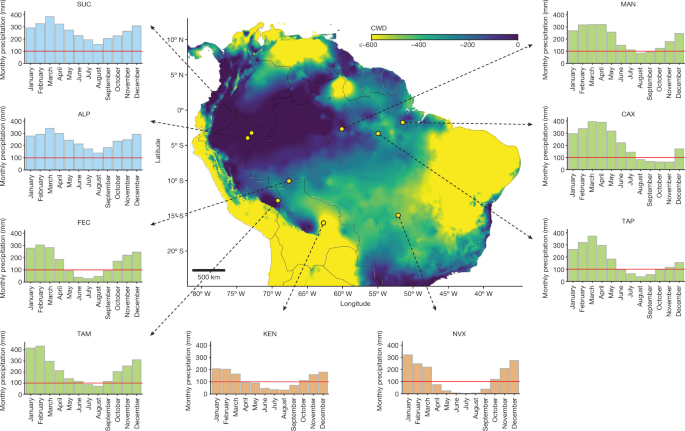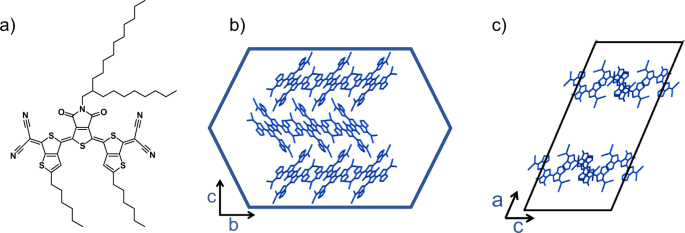2023-04-26 バーミンガム大学
科学者たちは、西部と南部のアマゾンにおいて、木々が最も枯死の危険にさらされていると予測している。これは、過去の研究が熱帯雨林の中東部に焦点を当てており、最も乾燥に強い部分については評価を行っていなかったため、乾燥による影響が過小評価されていた可能性があるためである。
また、この調査は、異なる地域が暖かく乾燥した気候にどのように反応するかについての初めての評価を提供するものであり、一部の研究では、アマゾン熱帯雨林が乾燥期間の増加を経験すると予測されている。
<関連情報>
- https://www.birmingham.ac.uk/news/2023/how-the-amazon-rainforest-is-likely-to-cope-with-the-effect-of-future-drought
- https://www.nature.com/articles/s41586-023-05971-3
アマゾン森林の炭素収支を予測する樹木の水力安全マージンの流域幅の変動 Basin-wide variation in tree hydraulic safety margins predicts the carbon balance of Amazon forests
Julia Valentim Tavares,Rafael S. Oliveira,Maurizio Mencuccini,Caroline Signori-Müller,Luciano Pereira,Francisco Carvalho Diniz,Martin Gilpin,Manuel J. Marca Zevallos,Carlos A. Salas Yupayccana,Martin Acosta,Flor M. Pérez Mullisaca,Fernanda de V. Barros,Paulo Bittencourt,Halina Jancoski,Marina Corrêa Scalon,Beatriz S. Marimon,Imma Oliveras Menor,Ben Hur Marimon Jr,Max Fancourt,Alexander Chambers-Ostler,Adriane Esquivel-Muelbert,Lucy Rowland,Patrick Meir,Antonio Carlos Lola da Costa,Alex Nina,Jesus M. B. Sanchez,Jose S. Tintaya,Rudi S. C. Chino,Jean Baca,Leticia Fernandes,Edwin R. M. Cumapa,João Antônio R. Santos,Renata Teixeira,Ligia Tello,Maira T. M. Ugarteche,Gina A. Cuellar,Franklin Martinez,Alejandro Araujo-Murakami,Everton Almeida,Wesley Jonatar Alves da Cruz,Jhon del Aguila Pasquel,Luís Aragāo,Timothy R. Baker,Plinio Barbosa de Camargo,Roel Brienen,Wendeson Castro,Sabina Cerruto Ribeiro,Fernanda Coelho de Souza,Eric G. Cosio,Nallaret Davila Cardozo,Richarlly da Costa Silva,Mathias Disney,Javier Silva Espejo,Ted R. Feldpausch,Leandro Ferreira,Leandro Giacomin,Niro Higuchi,Marina Hirota,Euridice Honorio,Walter Huaraca Huasco,Simon Lewis,Gerardo Flores Llampazo,Yadvinder Malhi,Abel Monteagudo Mendoza,Paulo Morandi,Victor Chama Moscoso,Robert Muscarella,Deliane Penha,Mayda Cecília Rocha,Gleicy Rodrigues,Ademir R. Ruschel,Norma Salinas,Monique Schlickmann,Marcos Silveira,Joey Talbot,Rodolfo Vásquez,Laura Vedovato,Simone Aparecida Vieira,Oliver L. Phillips,Emanuel Gloor & David R. Galbraith Published:26 April 2023
DOI:https://doi.org/10.1038/s41586-023-05971-3
Nature

Abstract
Tropical forests face increasing climate risk1,2, yet our ability to predict their response to climate change is limited by poor understanding of their resistance to water stress. Although xylem embolism resistance thresholds (for example, Ψ50) and hydraulic safety margins (for example, HSM50) are important predictors of drought-induced mortality risk3,4,5, little is known about how these vary across Earth’s largest tropical forest. Here, we present a pan-Amazon, fully standardized hydraulic traits dataset and use it to assess regional variation in drought sensitivity and hydraulic trait ability to predict species distributions and long-term forest biomass accumulation. Parameters Ψ50 and HSM50 vary markedly across the Amazon and are related to average long-term rainfall characteristics. Both Ψ50 and HSM50 influence the biogeographical distribution of Amazon tree species. However, HSM50 was the only significant predictor of observed decadal-scale changes in forest biomass. Old-growth forests with wide HSM50 are gaining more biomass than are low HSM50 forests. We propose that this may be associated with a growth–mortality trade-off whereby trees in forests consisting of fast-growing species take greater hydraulic risks and face greater mortality risk. Moreover, in regions of more pronounced climatic change, we find evidence that forests are losing biomass, suggesting that species in these regions may be operating beyond their hydraulic limits. Continued climate change is likely to further reduce HSM50 in the Amazon6,7, with strong implications for the Amazon carbon sink.



